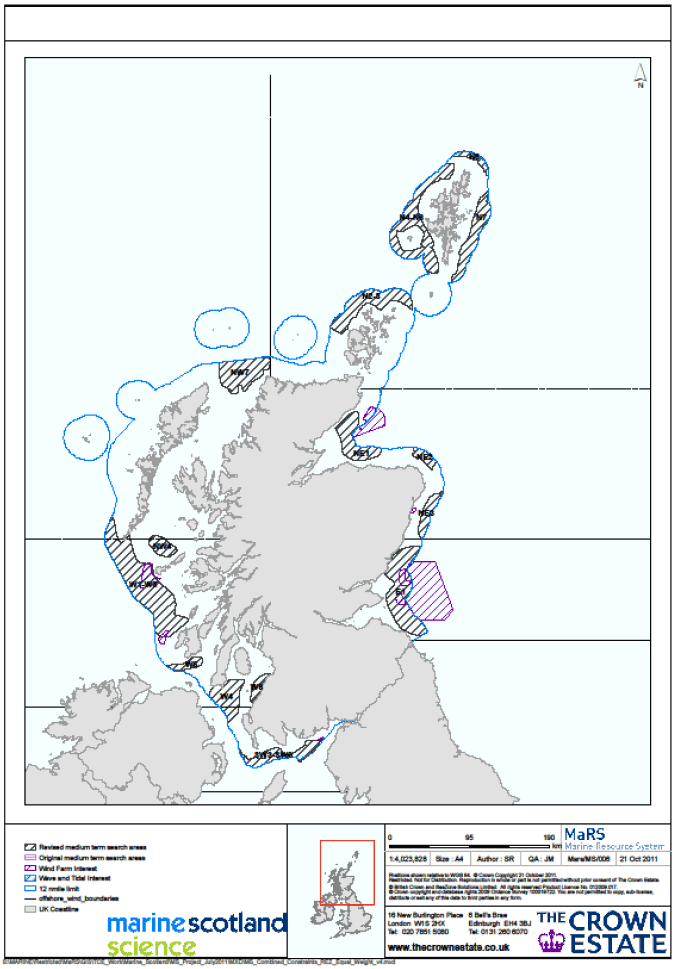Scottish Marine and Freshwater Science Report Volume 2 Number 13
This report describes the process employed by Marine Scotland to identify strategic search areas for future commercial scale offshore wind developments in Scottish Territorial Waters (STW). It also presents the first discussion of the development potential outside STW out to 200 nm
Executive Summary
The Scottish Government has set a range of challenging targets for energy and climate change. These recognise the potential to take advantage of the extensive marine energy resources (wind, wave and tidal power) available in Scottish waters and include meeting at least 30% of total energy demand from renewable sources by 2020, incorporating:
- 100% of electricity demand from renewables (31% by 2011)
- 11% of heat demand from renewables
- 10% of transport fuel from renewables
In addition, the Climate Change (Scotland) Act 2009 sets statutory targets of at least 42% emissions cuts by 2020, and at least 80% by 2050.
To assist in meeting these targets, a Sectoral Marine Plan for Offshore Wind Energy in Scottish Territorial Waters (Blue Seas - Green Energy) sets out the Government's vision for developing offshore wind energy up to 2020 and beyond and has identified short term development sites for offshore wind up to 2020, with a potential to deliver almost five Gigawatts ( GW) of electricity generation capacity; and a further 25 areas for further exploration beyond 2020. Currently, up to 10 GW of planned development is in progress at offshore wind sites in Scottish Waters, divided roughly equally between Round 3 sites and sites in Scottish Territorial Waters ( STW).
A sensitivity analysis of the process used to develop the Plan concluded that, as additional data and monitoring information, and improved data handling procedures, become available, these should be incorporated into the emerging iterative marine planning process, as applied to the medium term options for wind farm development in STW, and to opportunities further offshore.
A process was therefore put in place by Marine Scotland to develop a Scoping Report for the potential for offshore wind development in Scottish waters out to 200 nautical miles. This report describes the process employed by Marine Scotland in collaboration with The Crown Estate to develop a series of new offshore wind plan options within STW, and presents the first discussion of development potential outside STW out to 200 nm.
The Crown Estate spatial modelling tool MaRS was used to create multi-factorial expressions of the technical opportunities and constraints on offshore wind development in Scottish waters, and of the constraints on consenting presented by themed groups of factors. These themes reflect current commercial (industrial) activities such as fishing, aquaculture and offshore oil and gas, environmental factors such as designated Natura sites, and a broad field of "heritage" interests including recreational uses, archaeological potential, visual and landscape factors. These models have been combined and used to develop overall expressions of the relative degrees of constraint. The sensitivity of the process was investigated through the creation of a series of combined models altering the relative influence of each the themes. Considerable similarities were found between the combined models, and the model that weights the three themes equally was taken forward and used to develop plan options for offshore wind within STW.
The options indentified are shown in Figure S1 and listed below.
Potential plan option areas within Scottish Territorial Waters identified in the scoping study:
E1 Off the Firths of Forth and Tay
NE1 In the inner Moray Firth
NE2 In the south eastern part of the Moray Firth
NE3 Off the east coast of Aberdeenshire
N2-3 North of Orkney
N4-6 West of Shetland
N7 East of Shetland
N8 North of Shetland
NW7 North Minch
NW4 South MInch
W1-3 Sea of the Hebrides
W4 South of Islay
W5 South of Islay
W6 West of Ayrshire
SW3-6 Solway region
Figure S1 Offshore wind plan option areas identified within Scottish territorial waters, and offshore wind development areas currently within the Marine Scotland Marine Licence process.

Sea areas outside STW generally have greater depths of water, and also generally lower levels of constraint, reflecting the greater importance of coastal waters to commercial, environmental and heritage interests. A discussion of potential plan options outside STW is therefore structured around depth zones. Potential development areas with water depths less than 60m are identified in the Forth and Tay area, and in the Moray Firth, adjacent to TCE Round 3 lease areas which are currently in the in the process leading to application for Marine Licence and other consents. Further areas of 60 - 80 m depth are found in the same general areas, and may represent development opportunities once the technology for working in such depths of water is established. There is also a potential development area north of Orkney with 60 - 80 m depth.
There are large areas of water of 80 - 120 m depth. These areas are not currently amenable to fixed foundation turbine structures, but may be suitable for floating turbine systems. Very extensive areas in this depth range are found in the Scottish waters in the North Sea.
Areas of water of 120 - 300m depth are unlikely to be considered as priority development opportunities. The Fladen Ground in the North Sea presents the most practicable opportunities in this depth zone, while the extensive exposed area along the shelf edge west of Scotland presents very considerable technical challenges to development and may not be practicable for some years.
The outputs from this study will inform the marine planning process by leading to the development of Regional Locational Guidelines for offshore wind development, which in turn will be the basis for an SEA to cover wind farm development in Scottish waters.
There is a problem
Thanks for your feedback